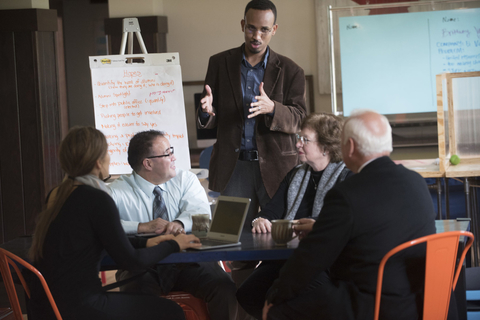Key concept
To convene a meeting that makes progress, take time beforehand to clarify its purpose and plan an agenda. Planning a thoughtful agenda with tasks and processes that engage group members will help create more effective meetings and good results.
How can you plan for an effective meeting?
Tip: Create an agenda with a purpose
Public meetings should make progress toward the goal of solving public problems. Learn in the following sections an important way to plan public gatherings that help groups achieve goals.
Consider purpose and process
When you are leading a meeting, it is your responsibility to plan the agenda. If you have been asked to facilitate someone else's meeting, meet with conveners ahead of time to plan it. If you are a group member, judge whether it is appropriate to offer help creating an agenda beforehand.
Whoever is involved, the key early step to designing an effective meeting is to be very clear about its purpose. Once the purpose is clear, communicate it to those involved, and plan meeting strategies that support the thoughtful involvement of those attending.
Sending an agenda before a meeting lets participants know what will be discussed, and gives them time to think about what you will discuss. If that's not possible, an agenda created on the spot as the meeting starts still gives the meeting important focus.
Steps for planning a meeting agenda
Here's the sequence of steps to plan an effective meeting agenda.
-
Define results first. What are the results your group needs to achieve by the end of the meeting? Write them down. If there is not a defined purpose, consider whether there really is a reason to meet.
-
Identify the meeting's time frame. What kind of meeting time is needed for the meeting's purpose? Different time frames fit different purposes — from the five-minute daily check-in to the two-day retreat. Match the amount of time to the needs and the frequency of the group's gathering.
-
List the meeting's topics. Identify the topics that need to be covered to accomplish the results. Think through what has to be done, consider a logical order for discussing the topics or making decisions. Consider the information that the group needs in order to discuss a topic or make a decision knowledgeably. A good agenda considers the following:
-
What topics do we have to cover to accomplish our goal?
-
What outcome/s do we want for each topic?
-
What information do we need?
-
Who will make the decision/s?
-
-
Allot time frames by topic. Considering the total time available, assign realistic time slots for each item. During the meeting, if the group hasn't reached a decision within the time provided, suggest next steps or refer the item to the next meeting or committee.
-
Plan participation strategies to address each topic. Different methods of discussion can be used to make the best use of the group for each topic. Be clear about expectations for involving participants to assure that involvement builds trust and gets authentic action.
-
Do a sanity check. After you review your agenda, consider whether what you want to do is really "doable" in the amount of time you've got. If not, scale back expectations or schedule another meeting to address some of the topics.
Suggested participation strategies
To get feedback, do a survey in advance or collect ideas at the meeting. The meeting leader can go around the table and ask each participant to share an idea until the list is complete. Listing ideas on a flip chart as they are mentioned helps everyone at the meeting see them all easily.
To get greater involvement in decisions, consider listing all ideas and giving participants several votes to cast. For example, each participant could place three votes among six-to-eight ideas. In the end, the group's preferred priorities are evident.
Kearny, L. (1995). The facilitator's tool kit: Tools and techniques for generating ideas and making decisions in groups. Amherst, MA: HRD Press.
Scheffert, D., Anderson, M., Anderson, S., et al. (2001). Facilitation resources, volume 3: Getting focused: Vision/mission goals. St. Paul, MN: University of Minnesota Extension.
How can Extension help
Extension leadership and civic engagement (LCE) educators work across the state of Minnesota. They provide educational programs and consultations that help communities solve problems and make decisions.
Contact an educator near you or program leader Holli Arp.


